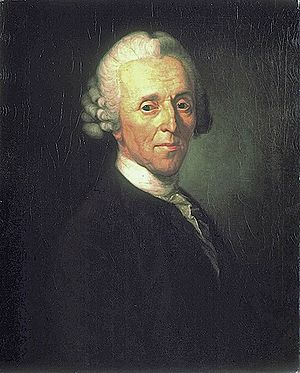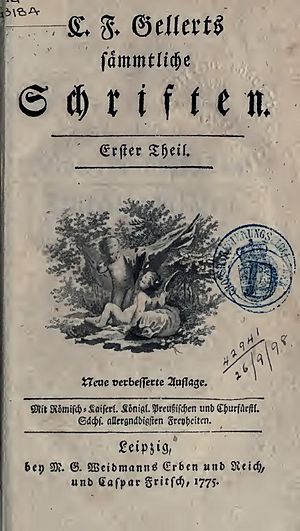Christian Fürchtegott Gellert facts for kids
Quick facts for kids
Christian Fürchtegott Gellert
|
|
|---|---|

Christian Fürchtegott Gellert. Painting by Anton Graff
|
|
| Born | 4 July 1715 Hainichen, Electoral Saxony, Holy Roman Empire
|
| Died | 13 December 1769 (aged 54) Leipzig, Electoral Saxony, Holy Roman Empire
|
Christian Fürchtegott Gellert (born July 4, 1715 – died December 13, 1769) was a famous German poet. He helped prepare the way for a "golden age" of German literature, which was later led by writers like Lessing.
Biography
Gellert was born in Hainichen, a town in Saxony, Germany. It was located near the Erzgebirge.
He went to school at St. Afra in Meissen. In 1734, he started studying theology (the study of religious faith) at Leipzig University. However, in 1738, he had to stop his studies. His family could no longer afford to support him. For a few years, he worked as a private tutor.
Gellert returned to Leipzig in 1741. He wrote for a magazine called Bremer Beiträge. This magazine was started by students who wanted to change how literature was taught.
Because he was shy and often sick, Gellert decided not to become a minister. But he finished his studies in 1743 and became a university lecturer in 1744. In 1745, he became a Privatdozent (a private lecturer) at Leipzig University. He taught about poetry, rhetoric (the art of speaking or writing effectively), and moral philosophy (the study of knowledge and values).
In 1751, he became an extraordinary professor of philosophy. He held this job until he passed away in Leipzig in 1769.
Works
Gellert was highly respected by his students and others. This was because of his kind and generous personality. He was known for being friendly, humble, and very religious.
He wrote to help people become more religious and moral. He used clear and correct language in his writings. This made him one of the most popular German authors of his time. Some of his poems became very famous.
His collection of fables and stories in verse, called Fabeln und Erzählungen, was a huge success. The first part came out in 1746, and the second in 1748. This book made him a well-known writer.
Another popular book was Geistliche Oden und Lieder (Spiritual Odes and Songs), published in 1758. It included hymns like "Herr, stärke mich, dein Leiden zu bedenken".
Gellert's fame also came from the time he lived in. Back then, German literature was controlled by strict rules. Gellert and other young writers wanted to break free from these old ways. They started a literary revolution that was later completed by famous writers like Schiller and Goethe.
The fables Gellert wrote were inspired by La Fontaine. They were simple and taught moral lessons. His religious poems were used as hymns by both Catholics and Protestants. One of his most famous hymns is "Die Ehre Gottes aus der Natur" ("The Heavens are Telling").
Gellert also wrote a few sentimental comedies:
- Die Betschwester (The Praying Sister, 1745)
- Die kranke Frau (The Sick Woman, 1747)
- Das Los in der Lotterie (1748)
- Die zärtlichen Schwestern (The Affectionate Sisters, 1747), which was very popular.
His novel Leben der schwedischen Gräfin von G. (1746) was an early German attempt at a psychological novel. It was similar to Pamela by Samuel Richardson.
Besides teaching many students about moral topics, Gellert also wrote many letters. He corresponded with both strangers and friends. Many people asked him for advice on moral questions. He was seen as a teacher of good writing style. In 1751, he published a book of example letters and an essay on how to write good letters.
Legacy
Beethoven, a famous composer, set six of Gellert's poems to music in 1803. These poems were from Gellert's Geistliche Oden und Lieder, including "Die Ehre Gottes aus der Natur". Some of Gellert's poems are still used as hymns today, such as "Wenn ich, o Schöpfer, deine Macht".
In 1857, writer Berthold Auerbach honored Gellert in his story "Gellerts letzte Weihnachten" (Gellert's Last Christmas).
See also
 In Spanish: Christian Fürchtegott Gellert para niños
In Spanish: Christian Fürchtegott Gellert para niños


